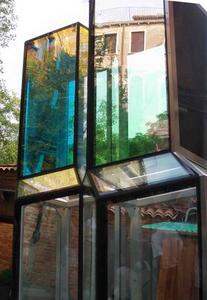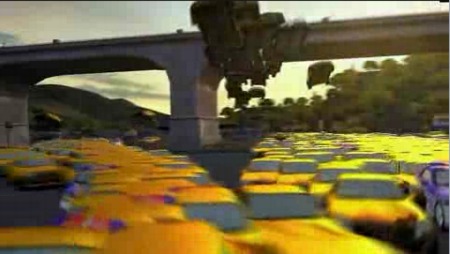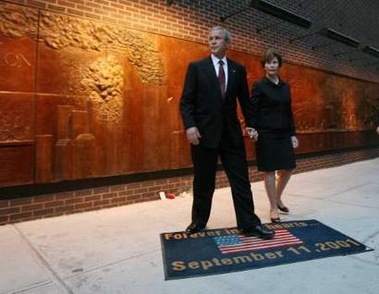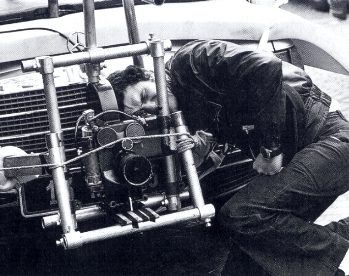It is really hard, apparently, to come away in a good mood when you’re a freelancer charged with writing about starchitects’ hyper-deluxe modernist loft developments where the price per square foot is more than your fee.
In Vanity Fair, AA Gill does a whiny but funny but ultimately tedious takedown of the lifestyle purveyors like Andre Balasz and Ian Schrager [and their Nouvel and H&dM lifestyles, respectively], which, in turn reminded me of an article in Departures, the American Express magazine on nearly the same subject.
Curbed quotes Gill very well, so I’ll leave him be [but not without pointing out that he’s romanticizing our homeless street freaks from the cozy charmes of his apartment in London]; but Penelope Green’s AmEx article, though far more civilized, thank you very much, essentially validates Gill’s thesis that this extremely expensive, modern, luxe, minimalist lifestyle is not “about” New York; it’s a global phenomenon distributed along the flight ranges of Gulfstream V’s.
Below are some choice tidbits from Green’s piece [which may or may not be accessible online to non-Platinum and Centurion Cardmembers, so apologies in advance if you get stiff-armed for your demographic undesirability]. It all makes me wonder where all the billionaire freelancers are who can write about this stuff from a practical perspective, free of all the baggage of raging unattainability and deflated despair that inevitably creeps in. Please, billionaires, won’t you write more magazine articles?
I’m Venice Super Blog! Thanks For Asking!

The Venice Biennale of Architecture may have been a critical bust–both the Times’ and the Guardian’s people panned it, complaining that it’s a book in exhibition format, or text and videos but no architecture–but I have to say, it works OK for me as a blog.
MoMA’s A&D Dept. and some other folks–a lot of other folks, actually–have whipped together the Venice Super Blog, with a veritable DVD-ful of audio interviews, video clips, and Giardini gossip. It’s a bit too inside football sometimes, and sometimes the posters are a bit too pleased with themselves for attending [gee, if the “entire Architecture World” really is under the stairs of the British Pavillion with you, who’s supposed to be reading this?], but there’s interesting enough content to make it worth reading/listening/watching.
Some personal picks: Olafur Eliasson talking about his collaboration with architects, including work on the Icelandic Concert and Conference Centre, and David Adjaye’s pavillion for an OE installation. Here’s a wrap-up of a panel discussion about the pavillion project, Your Black Horizon. And here’s a photo of a 1:1 mockup of the IC&CC semi-reflective crystalline facade. [above]
Rem Koolhaas and his thinktank side, AMO, did a presentation on resort developments in Dubai–Olafur calls it “Rem talking about his golf course project in Dubai”–and the modernist building boom throughout the Persian Gulf. Here’s a brief interview, and here’s an even briefer recap.
Besides more useful tags or navigation, it’s the one thing VeniceSuperBlog could’ve done better: raw, liveblogged info. Maybe it’s a problem of too many chief curators and not enough interns.
Spectacular Machinima Music Video

From 100 anime movies, to 1,000 cloned machinima race cars. Here’s an incredible experiment in fluid dynamics, a flock of a thousand cars at once careening through Trackmania to a Moby soundtrack.
The 1k Project, uploaded by smull [gametrailers.com via wonderland]
Awesome Anime Sampling: The Race

Imagine Christian Marclay’s multi-channel movie mosaic masterpiece, Video Quartet, but done entirely with anime–and with a little bit of narrative laid over the top.
That’s Istiv Studio’s The Race, which is made up of clips and rotoscoped characters from over a hundred anime films, laid over a Weezer soundtrack. A pretty awesome way to spend a year of nights and weekends.
The Race by Istiv Studio [google video via boingboing]
Branding Man
I know a lot of you have been asking yourselves, “Hey, what’s been going on with Greg and the Belgian Waffle?” No? Too bad. Cuz I’ll tell you.
The Burning Man curator known as LadyBee and I have been going back and forth in email over whether Uchronia’s creators co-opted Burning Man as a backdrop for their own alternabrand-enhancing PR, whether the 1,000+ photos on flickr tagged with Uchronia constitutes a brand now, or whether Arne Quinze and his co-designers are just sending out 50,000 books and DVD’s to “people in important or influential positions who help shape the socio-economic landscape and can make a difference” anonymously and with no expectation of personal benefit.
Now, as you can imagine, an MBA, ex-consultant, ex-banker would have a hard time taking a credible stand against marketing, branding, or PR, but that’s not my point, and it hasn’t been. I don’t think there is anything intrinsically wrong with marketing per se, but I give Burning Man the institution full credit for not launching Black Rock Consulting, but instead sticking to their non-commercially exploitative guns.
But it’s naive of me to have thought as I have all these years, that Burning Man somehow exists apart from the society it sought to leave behind. Just as the environmental and resource impacts of the playa can’t be overlooked–they do still share a planet, an atmosphere, and a Wal-mart distribution infrastructure with the rest of society, after all–the notion that what happens in Black Rock City stays in Black Rock City is a fantasy. And all the bartering in the desert won’t change the fact that Burning Man is a brand and an institution in itself now, and it has associative value that the Uchronians identified and skilfully leveraged–and they did it in a way that has Burning Man veterans defending them.
While LadyBee has been pretty engaging, if resolute in her defense of the Uchronians, [“of course Arne puts them on his resume – and why shouldn’t he? He designed and built the thing. All our artists do that. If it strengthens his portfolio, fine. What marketing scheme do you think they’re going to unleash? Selling imported radiators to burners?” (Arne Quinze’s co-creator Jan Kriekels has a radiator company)], and she backed off a bit from her first email [“subject: greg – get a clue!”], the Belgian she roped into our exchange started with a really petty, thin-skinned personal attack.
Burning Man’s foundation is the idea that everyone could and should make art or express herself creatively. BRC is built on that creative exchange. Great. But Burning Man also has a curator, and a grant-making and evaluation process, which they use to dole out a portion of gate receipts to art proposals. It’s an institutional system that bears a remarkable ressemblance to the non-playa-based art world.
Uchronia itself was funded completely outside that institution, as LadyBee explained in an email to Burning Man’s staff [who’d apparently had some questions about the project, too.] And its team included between 45 and 60 “volunteers,” who, it turned out, were employees of the creators’ companies, and who worked at full salary, plus expenses, on the project. By that definition, Star Wars was a “volunteer” project, too.
Again, this is all totally cool, but it seems to me that if what happens at Burning Man doesn’t stay at Burning Man after all, and there are curatorial decisions being made and business transactions being done, then these people could respond a little better to criticisms, alternative interpretations, or a response that’s anything less than sheer, uncritical gratitude and ecstasy.
When Christo “gave” the “Gates” to the world, he kept trotting out his figure for how much he spent–$20 million, he said–while the boost the project gave his own art sales and holdings–in a private, pre-“Gates” interview, Jean-Claude claimed they had $400 million–was almost never mentioned.
The “Gates” was what it was, and Uchronia is what it is. But one of the things it is is a page in a portfolio for a “creator of atmosphere” who sells his own brand of edgy counter-cultural buzz to corporate clients like Compaq, Diesel, and Rem Koolhaas.
Standing Too Close To The Fire Of Burning Man

In a previous post, I characterized the Belgian designers behind Uchronia, a giant pavilion at Burning Man constructed by an army of their firms’ employees and others of new wood and then burned to the ground, as “self-aggrandizing eco-idiots.” Christine Kristen, aka LadyBee, the curator of art projects at Burning Man, takes issue with my characterization. The designers are not, it turns out, eco-idiots. Greg.org regrets the error.
LadyBee:
The Belgian project at Burning Man was a stellar example of community and generosity, funded by two Belgian business owners who regularly do community based art projects worldwide. The wood they used was last-quality Canadian wood destined for the dump. Additionally they are planting trees in Belgium equal to the wood used, and all leftover wood was donated to Burners without Borders, a Burning Man group that does relief work in Louisiana and Mississippi.
Get your facts straight before you criticize. You mean-spirited comments make you seem…petty and vindictive. I managed this project for Burning Man and there was virtually nothing objectionable in it. In fact these two business owners are trying to promote community through art-making and are very generous and forward thinking.
Though her explanation doesn’t entirely contradict Treehugger’s description of the wood used as “virgin pine,” it is a welcome correction.
For the rest of my response to LadyBee, see below. And for documentation of the Uchronia brand, check flickr.
Continue reading “Standing Too Close To The Fire Of Burning Man”
Where’s Scott Sforza when you need him?

There is actually discussion online that this photo has been Photoshopped and that GWB didn’t actually step on the flag during a photo-op visit to a September 11th memorial near the WTC Site.
Sorry, it’s very real. Reuters photos of the event show the flag mat [WTF??] pre-positioned precisely in front of the photographers’ position, a classic Sforzian composition, albeit one that went horribly wrong [as far as these things go.]
There are additional pictures of Laura Bush walking on the mat, and both of them standing on the flag. [Jason Reed/Reuters via Yahoo]
For Once, Nora, It’s Not Only You
Gawker Media: always pushing the envelope of integration of content and advertising.
“Does it smell like smoked mozzarella out here, or is it just me?” [gawker]
Wednesday In The Car With Claude

Now the story can be told. It’s interesting how long it takes stuff to bubble across the Internet. A recent spate of blog discussion of Claude Lelouch’s 1976 cult short film, C’etait un Rendezvous was prompted by the film’s mention in GQ this month. Similar waves of discovery and amazement accompanied, in reverse chronological order, the pairing up of Rendezvous with a follow-along Google Map, and a couple of years back, the film’s triumphal re-emergence on DVD after lingering for decades in bootleg-VHS obscurity.
But in the spring [Mercredi 24 Mai 2006, precisement], Lelouch took some French TV dude along to re-travel the route and talk about the making of the film. The result: answers for a lot of the rumors, questions, and legends that accumulated around the film. Too bad no one bothered to ask Lelouch before now. [But then again, my point is, I’m kind of bummed that I’m only finding this out now, four months after it was shot.]
1) Lelouch was driving
2) his Mercedes 6.9 [which he still has, which is one of my alltime favorite cars]
3) because the pneumatic suspension would produce a much smoother image.
4) The Ferrari audiotrack was dubbed in afterward.
5) The woman at the end is his wife.
6) The whole thing was done on a whim, after shooting something else with a car-mounted camera, and using a leftover magazine of film.
My favorite line of the whole interview: “Yes, I was scared. I was scared of running out of film.”
C’etait un Rendezvous The Making Of {youtube via jalopnik]
French discussion and transcript from April [axe-net.be]
Standing On The Shoulders Of Giants
In-Game Developer Commentary, In-Game Video Production
Andy has some video of some in-game developer commentaries that are included in the Half-Life 2: Episode One. They’re a cross between a typical DVD director’s commentary track, hyperlinked footnotes, and a first-person video tour. Fascinating.
Perhaps the coolest, though, is a commentary where they show how an in-game video projection–where a game character’s talking head appears on an in-game monitor–is made. Turns out the clip is actually “shot” “live” in a walled off part of the game, and “broadcast” to the monitor. It’s like in-game machinima or something, which is a bit to recursive for me. I think my head will explode.
Half Life Developers’ Commentary [waxy.org]
Artforum Reports From The 826NYC Benefit
Or, as I prefer to call it, “Let Us Now Praise Famous Men Andrew Hultkrans Would Like To Get Closer To.”
Called That One
The last mention of Lee Siegel on this blog was also the first. Since about three hours after he published that dumbass comment about Twombly, I’ve basically taken pains not to read his criticism. Life was just too short. And judging from the whorls of justified complaint and outrage in his online wake, I think it’s just as well.
For all the serious crit and insights into Siegel’s folly, the best response, though, has to be Dan‘s comment on Grammar.police, which came during a thread on Twombley’s Whitney show: “I frankly don’t think we can fully appreciate Twombly’s carpeting choice unless we understand that he is gay.”
Jed Perl, on the other hand, has duped me into reading him again and again, even though I usually find him to be a cranky and retrograde wet blanket. I guess I can’t fully appreciate Perl, even though I understand his taste in tapestries.
Advantage: Blogofascists [grammar.police via man]
Previously: Fatuous Writing Makes Art Lovers Head Explode!
How Conceptual Art Is Like A Renaissance Tapestry
Uh-oh, I Hope PS1 Doesn’t Find Out About This

A swoopy playground for hipsters built by an army of volunteers in an arid, rocky landscape? Alas, it appears they haven’t heard of reclaimed lumber in Belgium.
Uchronia, by Jan Kriekels and Arne Quinze at this year’s Burning Man Festival [sfgate via archinect]
Anyone who calls themselves “the spirituals”… plus, they built off the Black Rock City grid. [uchronians.org]
update: You’re kidding. these self-aggrandizing eco-idiots burned this thing, made of virgin pine, the night after The Man. [via treehugger]
Gerhard Richter’s Stained Glass Window For The Cologne Cathedral
It took over 600 years to complete [from 1248 t- 1880], so it should surprise absolutely no one that it takes the Cologne Cathedral [or Kölner Dom] over 60 years to fix a broken window.
Gerhard Richter has been commissioned to recreate a 20m tall window for the Cathedral’s south transverse; the original was blown out during World War II, and the design was lost. The new Richter window will consist of 11,500 handblown glass squares about 10cm each, in 72 different colors; the design was inspired by Richter’s 1974 presciently pixellated painting, 4,096 Colors, which has been overlaid onto window’s original Gothic mullions and tracery.
The top donors to the window’s fabrication costs [estimated at 350-400,000 euros] at the end of the year will receive a signed thank you memento from Richter, as well as invites to the Spring 2007 dedication. [I’d certainly hope so.]
Cologne Cathedral at wikipedia. also, see and read details in German at Koelner-dom.de [via artnet]




